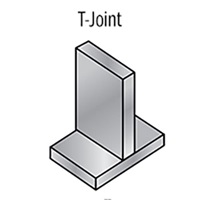
T-joint
A T-joint is created when the edges of your two workpieces meet at approximately 90 degrees and take the shape of a T. You'll weld the edge of one workpiece to the flat surface of another. T-joints possess good mechanical strength, especially when welded from both sides. You'll find these joints in many fabrication applications, including structural steel, tubing and equipment applications.
T-joints generally require little or no joint preparation and are easily welded when the correct parameters and techniques are used. You can leave the edges of the joint unaltered, or you can prep them by cutting, machining or grinding.
When welding a T-joint, it is important to place the weld on the same side of the joint that will be subject to any type of stress. Impact or load from the opposite side of the joint could cause the weld to fail. To avoid this, you can weld both sides to achieve maximum strength or when stress will be applied from both directions.
T-joints are the most common joint design in all applications. You can weld them fairly easily in the flat, horizontal, vertical or overhead position, while other joint designs can be more difficult to weld out of position.
When welding a T-joint with a 90-degree angle, it’s best to split the difference using a 45-degree work angle to ensure you will achieve proper penetration on both workpieces. If you’re welding dissimilar metal thicknesses using a T-joint, focus more of your weld onto the thicker piece of material.